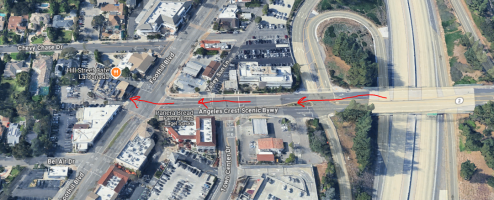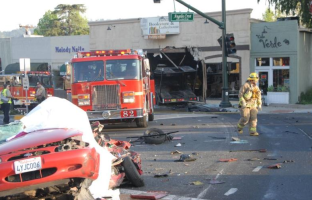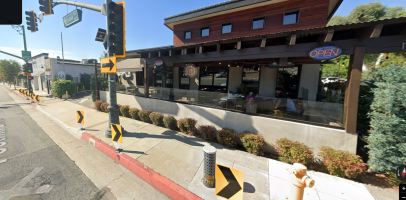Every day in the United States, vehicles crash into buildings more than 100 times, resulting in approximately 16,000 injuries and 2,600 deaths annually. These incidents, often categorized as "storefront crashes," occur at an alarming rate, yet there is little regulation in place to prevent them. The majority of these crashes happen at low speeds in parking lots, where simple safety measures like bollards could make a significant difference in reducing injuries, deaths, and property damage. Despite the overwhelming evidence supporting their effectiveness, too many businesses and lawmakers hesitate to require them, often citing the flawed argument that "they won't stop everything." The reality is that while bollards may not be able to stop every vehicle, they drastically reduce the risk in the most common scenarios, and that alone makes them a necessary investment.
Statistics paint a clear picture of the risk. The leading cause of storefront crashes is driver error, particularly pedal misapplication, which accounts for about 41% of incidents. Drivers, especially the elderly or inexperienced, mistakenly press the gas instead of the brake, sending their vehicles careening over curbs and into unsuspecting pedestrians, storefronts, and businesses. Another 15% of incidents are due to impaired driving, and 12% result from traffic collisions pushing vehicles into buildings. Medical emergencies, such as heart attacks or seizures, account for another 9%, while intentional crashes, including ram-raids for theft, make up around 6% of cases. In all these situations, bollards and similar protective barriers could mitigate damage, slow down the vehicle, or even prevent the impact entirely.
Opponents of requiring bollards often argue that they cannot prevent every crash, especially at high speeds. This is an irrelevant point. Most storefront crashes occur in parking lots, where vehicles have little room to accelerate to dangerous speeds. The vast majority of these incidents happen at low speeds—enough to cause severe injuries but within the stopping power of properly installed barriers. Even if a bollard does not completely stop a vehicle, it can slow it down enough to minimize damage, give people time to react, and reduce the severity of injuries. The goal is not perfection; the goal is prevention where it is possible, and bollards accomplish that exceptionally well.
Not all bollards are created equal, and this is an area where standardization is essential. Some businesses have installed decorative bollards that serve no structural purpose, while others have used cheap bollards that are simply bolted into concrete and can easily shear off upon impact. To be effective, bollards must be designed to withstand vehicle strikes. The most reliable bollards are made of steel, filled with concrete, and embedded deep into the ground. Properly installed security bollards should extend at least three feet into reinforced concrete footings to ensure they are immovable upon impact. Newer bollard technology has also improved their effectiveness while maintaining cost efficiency. Crash-rated bollards, which meet ASTM or K-rated standards, are designed to stop vehicles of specific sizes traveling at set speeds. Some modern bollards feature energy-absorbing designs that reduce impact force, minimizing injury to drivers while still preventing vehicle penetration. The key is ensuring that regulations require tested and certified barriers, not weak, surface-mounted posts that provide little real protection. Addressing this issue in legislation will prevent opponents from arguing that ineffective bollards invalidate the concept entirely.
Some local governments have recognized the urgency of this issue and have enacted ordinances requiring barriers in front of high-risk businesses. After a devastating crash at a dentist's office in Midfield, Alabama, that killed a six-year-old girl, the city passed a law requiring protective barriers where parking is within 10 feet of an entrance. Orange County, Florida, responded to the death of a four-year-old girl at a daycare crash by requiring barriers at childcare facilities near parking areas. Malibu, California, has implemented stricter parking lot safety standards to prevent vehicles from jumping curbs. Miami-Dade County requires that head-in parking spaces directly in front of a storefront be protected by a substantial barrier, and some cities in California mandate bollards for businesses with outdoor seating. While these efforts are commendable, they are not nearly widespread enough.
Businesses often hesitate to install bollards due to perceived costs, but the financial impact of a single crash far outweighs the price of prevention. Installing a series of bollards typically costs between $8,000 and $12,000 for a storefront—an investment that lasts decades. Meanwhile, the cost of a single storefront crash, even one without fatalities, can easily exceed $50,000 in repairs, lost revenue, legal liabilities, and increased insurance premiums. If injuries or fatalities occur, settlements and lawsuits can run into the millions. Some insurance companies have begun offering premium discounts for businesses that install bollards, recognizing their effectiveness in mitigating risk. From a cost-benefit standpoint, the decision to install barriers is a no-brainer.
Beyond the financial impact, storefront crashes leave a trail of devastation. In Hingham, Massachusetts, an SUV plowed into an Apple Store at high speed, killing one person and injuring 19 others. The store had no bollards, despite being in a high-traffic shopping area with direct parking access. In Newton, Massachusetts, a driver with a medical condition lost control of his SUV and crashed into a pizzeria, killing two and injuring seven. A crash outside Farrell’s Ice Cream Parlour in California saw an elderly driver mistakenly accelerate into a crowd, killing a woman and seriously injuring a child. In Orlando, a vehicle pushed into a daycare center, killing a young girl and injuring 15. All of these incidents had something in common: they could have been mitigated or prevented entirely by properly installed safety barriers.
Bollards are not an experimental solution; they are a proven method of preventing tragedies. High-profile companies like Target have installed decorative bollards that blend seamlessly into their storefronts while providing critical protection. Other businesses are slowly following suit, but voluntary adoption is not enough. When it comes to public safety, leaving preventative measures up to individual businesses creates inconsistencies and unnecessary risks. If a parking lot has spaces directly in front of a business entrance, there is a documented risk of a vehicle-into-building crash. This should be enough reason to require barriers, yet many jurisdictions still do nothing, waiting until after a tragedy strikes before considering action.
The reality is that many major chain stores have already recognized the importance of bollards and have implemented them as standard safety measures. Companies like Walmart, Target, Wawa, Sheetz, Turkey Hill, and numerous others have installed bollards in front of their entrances to protect customers, employees, and buildings. These businesses understand the risks and have acted accordingly, yet smaller businesses and municipalities often lag behind. If some of the largest retailers in the country see the value in these protective measures, there is no reason why they should not be required universally. The precedent has already been set, and it is time for regulations to catch up.
There is no valid argument against bollards. They are affordable, effective, and can be designed to blend into any commercial landscape. The data overwhelmingly supports their necessity. If they prevent even a fraction of storefront crashes, they will save lives, reduce injuries, and protect businesses from financial devastation. The claim that they “won’t stop every crash” is not an excuse for inaction. No safety measure is perfect, but reducing risk by even 50% or more is a massive improvement over doing nothing. The time for excuses has passed. Bollards should be a requirement in all commercial settings where parking directly faces storefronts, and anything less is a failure to protect the public from a well-documented and entirely preventable danger.
References:
Statistics paint a clear picture of the risk. The leading cause of storefront crashes is driver error, particularly pedal misapplication, which accounts for about 41% of incidents. Drivers, especially the elderly or inexperienced, mistakenly press the gas instead of the brake, sending their vehicles careening over curbs and into unsuspecting pedestrians, storefronts, and businesses. Another 15% of incidents are due to impaired driving, and 12% result from traffic collisions pushing vehicles into buildings. Medical emergencies, such as heart attacks or seizures, account for another 9%, while intentional crashes, including ram-raids for theft, make up around 6% of cases. In all these situations, bollards and similar protective barriers could mitigate damage, slow down the vehicle, or even prevent the impact entirely.
Opponents of requiring bollards often argue that they cannot prevent every crash, especially at high speeds. This is an irrelevant point. Most storefront crashes occur in parking lots, where vehicles have little room to accelerate to dangerous speeds. The vast majority of these incidents happen at low speeds—enough to cause severe injuries but within the stopping power of properly installed barriers. Even if a bollard does not completely stop a vehicle, it can slow it down enough to minimize damage, give people time to react, and reduce the severity of injuries. The goal is not perfection; the goal is prevention where it is possible, and bollards accomplish that exceptionally well.
Not all bollards are created equal, and this is an area where standardization is essential. Some businesses have installed decorative bollards that serve no structural purpose, while others have used cheap bollards that are simply bolted into concrete and can easily shear off upon impact. To be effective, bollards must be designed to withstand vehicle strikes. The most reliable bollards are made of steel, filled with concrete, and embedded deep into the ground. Properly installed security bollards should extend at least three feet into reinforced concrete footings to ensure they are immovable upon impact. Newer bollard technology has also improved their effectiveness while maintaining cost efficiency. Crash-rated bollards, which meet ASTM or K-rated standards, are designed to stop vehicles of specific sizes traveling at set speeds. Some modern bollards feature energy-absorbing designs that reduce impact force, minimizing injury to drivers while still preventing vehicle penetration. The key is ensuring that regulations require tested and certified barriers, not weak, surface-mounted posts that provide little real protection. Addressing this issue in legislation will prevent opponents from arguing that ineffective bollards invalidate the concept entirely.
Some local governments have recognized the urgency of this issue and have enacted ordinances requiring barriers in front of high-risk businesses. After a devastating crash at a dentist's office in Midfield, Alabama, that killed a six-year-old girl, the city passed a law requiring protective barriers where parking is within 10 feet of an entrance. Orange County, Florida, responded to the death of a four-year-old girl at a daycare crash by requiring barriers at childcare facilities near parking areas. Malibu, California, has implemented stricter parking lot safety standards to prevent vehicles from jumping curbs. Miami-Dade County requires that head-in parking spaces directly in front of a storefront be protected by a substantial barrier, and some cities in California mandate bollards for businesses with outdoor seating. While these efforts are commendable, they are not nearly widespread enough.
Businesses often hesitate to install bollards due to perceived costs, but the financial impact of a single crash far outweighs the price of prevention. Installing a series of bollards typically costs between $8,000 and $12,000 for a storefront—an investment that lasts decades. Meanwhile, the cost of a single storefront crash, even one without fatalities, can easily exceed $50,000 in repairs, lost revenue, legal liabilities, and increased insurance premiums. If injuries or fatalities occur, settlements and lawsuits can run into the millions. Some insurance companies have begun offering premium discounts for businesses that install bollards, recognizing their effectiveness in mitigating risk. From a cost-benefit standpoint, the decision to install barriers is a no-brainer.
Beyond the financial impact, storefront crashes leave a trail of devastation. In Hingham, Massachusetts, an SUV plowed into an Apple Store at high speed, killing one person and injuring 19 others. The store had no bollards, despite being in a high-traffic shopping area with direct parking access. In Newton, Massachusetts, a driver with a medical condition lost control of his SUV and crashed into a pizzeria, killing two and injuring seven. A crash outside Farrell’s Ice Cream Parlour in California saw an elderly driver mistakenly accelerate into a crowd, killing a woman and seriously injuring a child. In Orlando, a vehicle pushed into a daycare center, killing a young girl and injuring 15. All of these incidents had something in common: they could have been mitigated or prevented entirely by properly installed safety barriers.
Bollards are not an experimental solution; they are a proven method of preventing tragedies. High-profile companies like Target have installed decorative bollards that blend seamlessly into their storefronts while providing critical protection. Other businesses are slowly following suit, but voluntary adoption is not enough. When it comes to public safety, leaving preventative measures up to individual businesses creates inconsistencies and unnecessary risks. If a parking lot has spaces directly in front of a business entrance, there is a documented risk of a vehicle-into-building crash. This should be enough reason to require barriers, yet many jurisdictions still do nothing, waiting until after a tragedy strikes before considering action.
The reality is that many major chain stores have already recognized the importance of bollards and have implemented them as standard safety measures. Companies like Walmart, Target, Wawa, Sheetz, Turkey Hill, and numerous others have installed bollards in front of their entrances to protect customers, employees, and buildings. These businesses understand the risks and have acted accordingly, yet smaller businesses and municipalities often lag behind. If some of the largest retailers in the country see the value in these protective measures, there is no reason why they should not be required universally. The precedent has already been set, and it is time for regulations to catch up.
There is no valid argument against bollards. They are affordable, effective, and can be designed to blend into any commercial landscape. The data overwhelmingly supports their necessity. If they prevent even a fraction of storefront crashes, they will save lives, reduce injuries, and protect businesses from financial devastation. The claim that they “won’t stop every crash” is not an excuse for inaction. No safety measure is perfect, but reducing risk by even 50% or more is a massive improvement over doing nothing. The time for excuses has passed. Bollards should be a requirement in all commercial settings where parking directly faces storefronts, and anything less is a failure to protect the public from a well-documented and entirely preventable danger.
References:
- Storefront Safety Council – Crash Data and Annual Statistics
- Streetsblog USA – Vehicle-Into-Building Crash Frequency Analysis
- Risk Management Magazine – Financial Costs of Storefront Crashes
- Local Ordinances: Midfield, AL; Orange County, FL; Malibu, CA; Miami-Dade, FL
- News Reports: Hingham Apple Store, Newton Sweet Tomatoes, Farrell’s Ice Cream, Orlando Daycare
- Reliance Foundry – Cost Estimates and Insurance Benefits of Bollards
- Storefront Safety Council – Legislative Efforts and Case Studies



